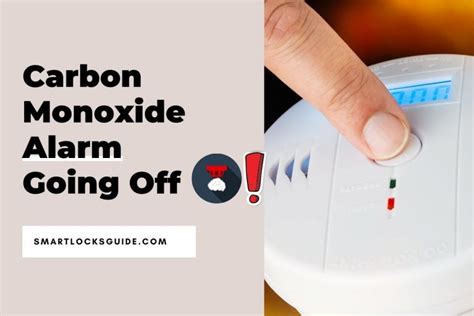A carbon monoxide (CO) alarm going off can be a frightening experience, but it’s important to stay calm and take action. CO is a colorless, odorless, and poisonous gas that can be deadly if inhaled in large amounts. That’s why it’s crucial to have a working CO alarm in your home and to know what to do if it goes off.

Why Do Carbon Monoxide Alarms Go Off Then Stop?
There are several reasons why a CO alarm might go off and then stop. Some of the most common include:
- Temporary CO spike: A sudden burst of CO, such as from a malfunctioning appliance or a clogged chimney, can trigger the alarm. Once the CO level drops, the alarm will reset itself.
- Faulty alarm: CO alarms can sometimes malfunction, causing them to go off even when there is no CO present.
- Low battery: A low battery can cause the alarm to malfunction or turn off completely.
What to Do If Your Carbon Monoxide Alarm Goes Off
If your CO alarm goes off, it’s important to take the following steps immediately:
- Evacuate your home: Get everyone out of the house and into fresh air. Do not re-enter the home until the CO level has been cleared.
- Call 911: Once you are safely outside, call 911 and report the CO alarm.
- Ventilate the home: If it is safe to do so, open windows and doors to ventilate the home.
- Check for sources of CO: Once the fire department has cleared the home, inspect your appliances and other potential sources of CO for any signs of malfunction.
How to Prevent Carbon Monoxide Poisoning
The best way to prevent CO poisoning is to take steps to reduce your exposure to the gas. Here are some tips:
- Install and maintain CO alarms: Install CO alarms in your home and test them regularly. Replace batteries according to the manufacturer’s instructions.
- Service your appliances: Have your heating appliances, such as furnaces and water heaters, serviced by a qualified technician annually.
- Keep chimneys and vents clear: Make sure your chimneys and vents are clear of any obstructions, such as leaves or debris.
- Use caution with portable generators: Never use a portable generator indoors, as this can create a build-up of CO.
- Be aware of symptoms of CO poisoning: Symptoms of CO poisoning include headache, nausea, dizziness, and confusion. If you experience any of these symptoms, get fresh air immediately and seek medical attention.
Conclusion
Carbon monoxide poisoning is a serious hazard, but it can be prevented by taking the necessary precautions. By installing and maintaining CO alarms, servicing your appliances, and being aware of the symptoms of CO poisoning, you can help to keep your family safe.
Additional Resources
FAQs
1. How often should I test my CO alarm?
You should test your CO alarm monthly.
2. What should I do if my CO alarm goes off and I can’t find a source of CO?
If you can’t find a source of CO and your alarm keeps going off, evacuate your home and call 911.
3. Can I use a hair dryer to ventilate my home after a CO leak?
No, you should not use a hair dryer to ventilate your home after a CO leak. Hair dryers can create sparks, which could ignite any remaining CO.
4. What are the symptoms of CO poisoning?
Symptoms of CO poisoning include headache, nausea, dizziness, and confusion. If you experience any of these symptoms, get fresh air immediately and seek medical attention.
5. Can I use a CO detector to detect other gases?
No, CO detectors are only designed to detect carbon monoxide.
6. How long does it take for CO to reach dangerous levels?
Dangerous levels of CO can be reached in as little as 30 minutes.
Tables
Table 1: Common Sources of Carbon Monoxide
| Source | CO Production (ppm) |
|---|---|
| Unvented gas fireplace | 100-200 |
| Malfunctioning furnace | 50-100 |
| Clogged chimney | 25-50 |
| Portable generator | 20-40 |
| Backdraft from water heater | 10-20 |
Table 2: Symptoms of Carbon Monoxide Poisoning
| Symptom | Level (ppm) |
|---|---|
| Headache | 100-200 |
| Nausea | 200-400 |
| Dizziness | 400-800 |
| Confusion | 800-1200 |
| Loss of consciousness | 1200+ |
Table 3: CO Alarm Thresholds
| Level (ppm) | Time to Alarm |
|---|---|
| 30 | 120 minutes |
| 50 | 60 minutes |
| 100 | 10 minutes |
| 200 | 2 minutes |
| 400 | 1 minute |
Table 4: Effective Strategies for Preventing CO Poisoning
| Strategy | How to Implement |
|---|---|
| Install CO alarms | Place CO alarms in bedrooms, living areas, and near potential sources of CO. |
| Test CO alarms | Test CO alarms monthly and replace batteries as needed. |
| Service appliances | Have heating appliances, such as furnaces and water heaters, serviced by a qualified technician annually. |
| Keep chimneys and vents clear | Inspect chimneys and vents for obstructions and clean as needed. |
| Use caution with portable generators | Never use a portable generator indoors. |
